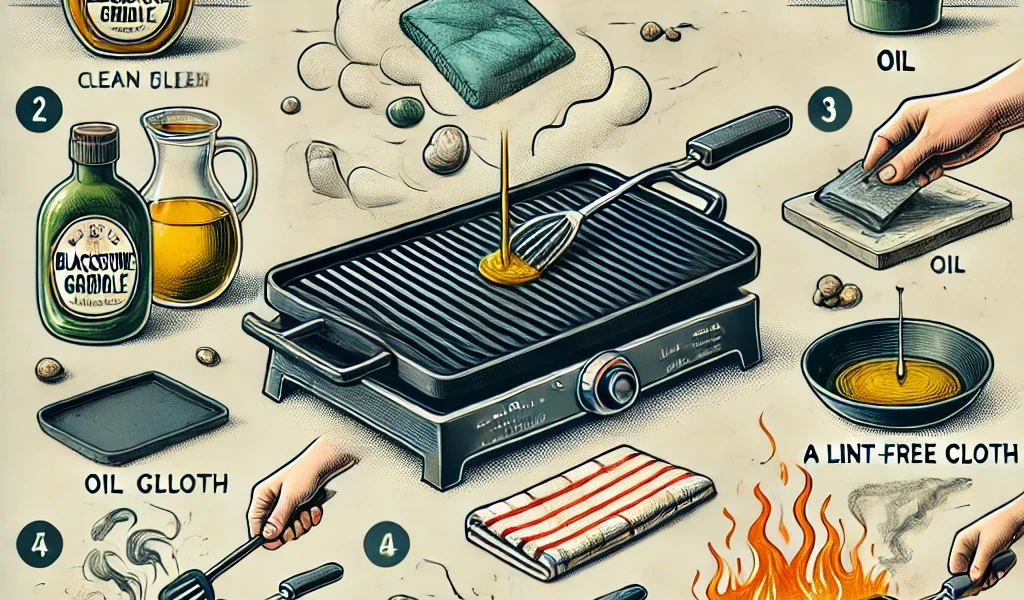The Best Way to Season a Blackstone Griddle: A Step-by-Step Guide
A well-seasoned griddle is essential for achieving the perfect cook on your Blackstone griddle. Not only does seasoning prevent food from sticking, but it also enhances the flavors and extends the life of your griddle by protecting it from rust and wear. Seasoning a griddle is similar to seasoning cast iron cookware, as it creates a natural, non-stick surface that improves over time. In this guide, we’ll walk you through the best way to season your Blackstone griddle to ensure optimal performance and longevity.
What Does It Mean to Season a Griddle?
Seasoning a griddle involves applying oil to the cooking surface and heating it to bond the oil to the metal. This process creates a durable, non-stick layer that protects the griddle from rust and enhances the flavor of the food you cook. Over time, as you continue cooking and re-seasoning, this layer becomes stronger, giving you better cooking results and making clean-up easier.
Why Seasoning is Important for a Blackstone Griddle
- Prevents Sticking: A properly seasoned griddle provides a non-stick surface that ensures your food doesn’t stick, making it easier to cook delicate items like eggs, pancakes, and fish.
- Prevents Rust: The oil layer created by seasoning acts as a barrier between the metal and moisture in the air, helping to prevent rust.
- Improves Durability: Regular seasoning adds strength to the surface of the griddle, allowing it to last longer and handle repeated use without wearing down.
- Enhances Flavor: As you cook on a seasoned griddle, it retains flavors from past meals, which enhances the taste of future dishes.
Tools and Materials You’ll Need
Before you begin the seasoning process, make sure you have the following tools and materials on hand:
- High smoke point oil (flaxseed oil, canola oil, vegetable oil, or grapeseed oil)
- Paper towels or a lint-free cloth
- Tongs or heat-resistant gloves
- A scraper (for cleaning)
- A grill brush (optional for cleaning)
- Blackstone griddle (new or cleaned)
Step-by-Step Guide to Seasoning a Blackstone Griddle
Step 1: Clean the Griddle Surface
Whether you’ve just purchased a new Blackstone griddle or are preparing to re-season an older one, you need to start by cleaning the cooking surface thoroughly.
- For a new griddle: Wipe down the surface with soap and water to remove any dust or residues left over from manufacturing. Rinse it well and let it dry completely.
- For a used griddle: Scrape off any food particles, grease, or burnt bits using a scraper. You can also use a grill brush to scrub away tougher debris. Once the surface is clean, rinse it with water and dry it thoroughly before proceeding.
Step 2: Preheat the Griddle
Turn on your Blackstone griddle and set it to high heat. Allow it to preheat for about 10 to 15 minutes. The griddle should start to darken and develop an even heat distribution across the surface.
Step 3: Apply the First Layer of Oil
Once the griddle is hot, it’s time to apply the first layer of oil. This is the most important step in the seasoning process.
- Pour 2 to 3 tablespoons of your chosen oil directly onto the surface of the griddle.
- Use a paper towel or lint-free cloth, held with tongs or heat-resistant gloves, to spread the oil evenly across the entire surface, including the sides and corners of the griddle.
Make sure the layer of oil is thin and even. If you use too much oil, it can create a sticky residue instead of forming a smooth, non-stick surface.
Step 4: Heat the Griddle to Bond the Oil
After spreading the oil, allow the griddle to heat until the oil begins to smoke. This process is called polymerization, and it’s crucial for creating the non-stick layer.
Let the oil smoke and burn off for 10 to 15 minutes, or until the smoking stops. You’ll notice the griddle’s surface becoming darker as the oil bonds to the metal. This is a sign that the seasoning layer is forming.
Step 5: Repeat the Process
To build a strong, durable seasoning layer, repeat steps 3 and 4 at least two or three more times. Each time, apply a thin layer of oil, let it smoke, and allow it to bond to the griddle surface. The more layers you apply, the better the non-stick surface will be.
After 3 to 4 rounds of seasoning, the griddle should have a dark, glossy finish, indicating that it is well-seasoned and ready for cooking.
Step 6: Cool Down the Griddle
Once you’ve finished the seasoning process, turn off the griddle and allow it to cool down completely. After it cools, the surface will have a smooth, non-stick finish, making it perfect for cooking your next meal.
Maintenance: How to Maintain the Seasoning on Your Blackstone Griddle
Seasoning your Blackstone griddle isn’t a one-time process. Over time, as you cook on it, the seasoning layer can wear down or develop spots. Here’s how you can maintain your seasoning:
- Re-season after each use: After cooking and cleaning the griddle, apply a thin layer of oil while it’s still warm. This helps maintain the protective coating and keeps the surface non-stick.
- Avoid soap: Don’t use soap to clean your griddle after it’s been seasoned, as this can strip away the seasoning layer. Instead, use warm water and a scraper to remove food residue.
- Regular deep cleaning: Every few months, give your griddle a deep clean by scraping off any excess grease or buildup and applying a fresh layer of seasoning.
- Protect it from moisture: To prevent rust, always dry your griddle thoroughly after cleaning and apply a thin coat of oil before storing it.
Best Oils to Use for Seasoning
Choosing the right oil is key to achieving a good seasoning layer. The best oils for seasoning are those with high smoke points, meaning they can withstand high temperatures without breaking down. Here are a few of the best oils to use:
- Flaxseed oil: This is often considered the best oil for seasoning cast iron and griddles due to its high smoke point and ability to form a hard, durable layer.
- Canola oil: A commonly used oil with a high smoke point, making it a good choice for seasoning.
- Vegetable oil: Readily available and affordable, vegetable oil is another solid option for seasoning a griddle.
- Grapeseed oil: Known for its neutral flavor and high smoke point, grapeseed oil is a great alternative for seasoning.
Conclusion
Properly seasoning your Blackstone griddle is essential to keeping it in great condition and ensuring a smooth, non-stick surface for cooking. By following the steps outlined above and regularly maintaining the seasoning, you can enjoy perfectly cooked meals and a griddle that lasts for years. Remember to use high smoke point oils, apply thin layers, and allow the griddle to heat thoroughly to achieve the best results. Whether you’re cooking breakfast, lunch, or dinner, a well-seasoned griddle will make the process easier and more enjoyable.




